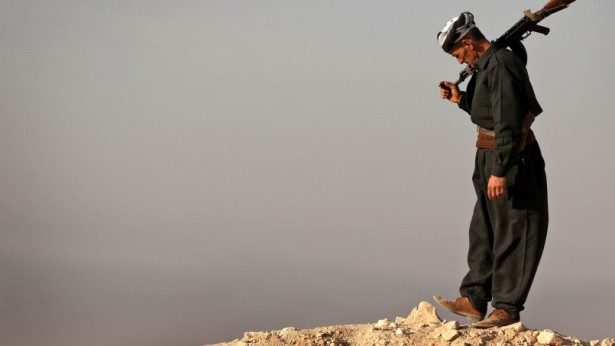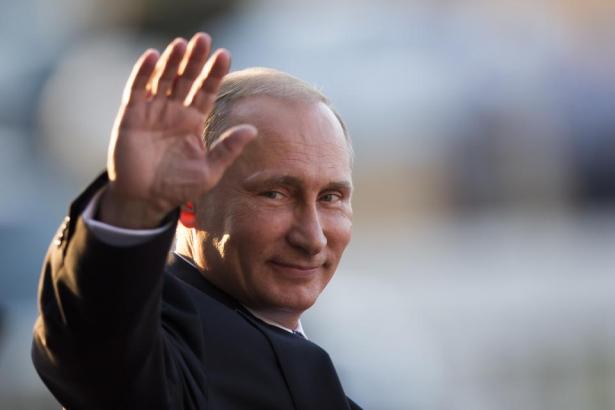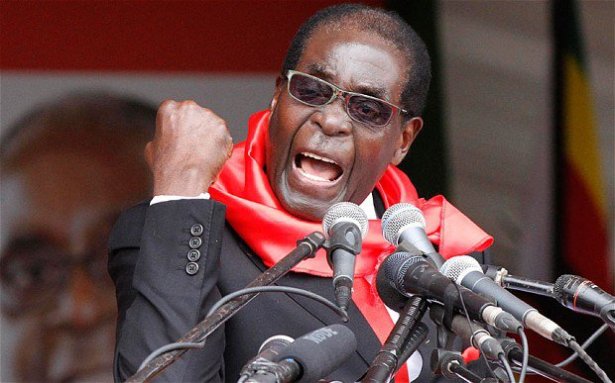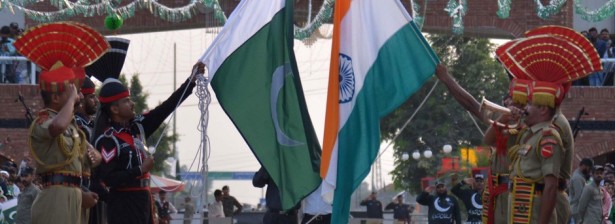
Image Credit: Safin Hamed/AFP/Getty Images
“It is tempting to think the Syrian civil war will end this year, but that is not the case.”
The United States will be no less engaged with the Middle East in 2017 than it was in 2016. It will, however, be more judicious in its engagement, giving other countries an opening to compete for influence. The competition will play out primarily in and around the Syria-Iraq battlefield, which will continue to implicate its neighbors and countries much farther afield. Developments in the fights inside Syria and Iraq will aggravate sectarian tensions and intensify the ongoing rivalry between Turkey and Iran.
Resisting the Temptation About Syria
It is tempting to think the Syrian civil war will end in 2017, now that the forces loyal to Bashar al-Assad have retaken the critical city of Aleppo. Indeed, they now control a few major cities and have the luxury of consolidating the gains they have made. But the conflict will not end, at least not in 2017. The loyalists are simply pulled in too many directions to achieve a decisive victory. In addition to holding their territory in the north, they must now try to clear the rebels located between Aleppo and Damascus and around Damascus itself. They will also be drawn to areas held by the Islamic State in the eastern city of Deir el-Zour, where their comrades are currently besieged. Retaking territory in the energy belt around Palmyra will be a priority too. Put differently, there is still a lot work left for them to do, and any number of things can shift the balance of power in such a conflict-ridden country.

The constraints on the loyalists, however, are but one factor preventing the conflict’s resolution. In 2017, the presence of foreign powers will also complicate the Syrian battlefield, much as it has in years past. The United States will adapt its strategy in Syria, favoring one that more selectively aids specific groups in the fight against the Islamic State rather than those fighting the al-Assad government. Washington will, for example, continue to back Kurdish forces but will curb support for rebels in Idlib. The consequences of which will be threefold. First, Turkey, Qatar and Saudi Arabia will have to increase their support for the rebels, including the more radical ones, the United States has forsaken. Second, their support will give radical elements room to thrive, as will the reduced oversight associated with Washington’s disengagement. Third, Russia will be able to cooperate more tactically with the United States and its allies as it tries to exact concessions, including the easing of sanctions, in a broader negotiation with Washington.
Notably, Russia will cooperate only insofar as it helps Moscow achieves those goals, but given Moscow’s limited influence on the ground in Syria, there is only so much it can actually do. Still, that will not stop Russia from trying to replace Washington as the primary arbiter of Syrian negotiation.
While other powers are preoccupied with the fight against the Islamic State, Turkey will expand its sphere of influence in northern Syria and Iraq, driven as it is by its imperative to block Kurdish expansion. In Syria, the presence of Russian troops will probably prevent Turkey from venturing any farther south than al Bab in northern Aleppo. From al Bab, Turkey will try to drive eastward toward the town of Manbij to divide and thus weaken areas held by the Kurds. Turkey will also lobby for a bigger role in anti-Islamic State operations in Raqqa. Turkey will deploy more of its own forces in the Syrian fight, both to obstruct the expansion of Syrian Kurdish forces and degrade the Islamic State.
There are, of course, some drawbacks to Turkey’s strategy. Namely, it runs the risk of clashes with Russian and Syrian Kurdish forces. Ankara will thus have to concentrate on maintaining closer ties with Moscow to avoid complications on the battlefield, even as it manages tensions with the United States over Washington’s continued support for the Kurds.
In Iraq, too, Turkey will extend its influence in the north – notably, to where the Ottoman Empire’s border was once drawn through Sinjar, Mosul, Erbil and Kirkuk. And as it does, it will compete with Iran for influence in the power vacuum left by the Islamic State’s defeat in Mosul. Baghdad, for its part, will struggle to control Nineveh province once the Islamic State loses Mosul. Meanwhile, Turkey will bolster its proxies to position itself as the patron state of the region’s Sunnis.
Turkey’s resurgence threatens Iran’s arc of influence across northern Syria and Iraq, and Tehran has plenty of ways it can respond. The government will encourage Shiites in Baghdad to resist what they will characterize as a Turkish occupation. It will also rely on Shiite militias to block Ankara by contesting territory and exploiting divisions among Iraqi Kurds. Saudi Arabia and the rest of the Gulf Cooperation Council, who have comparatively less influence Iraq, will rely on Turkey to uphold Sunni interests.
The fall of Mosul will further divide Iraq’s Kurds. The inevitable scramble for territory and influence will pit the Turkey-backed Kurdistan Democratic Party against the Patriotic Union of Kurdistan, which is more closely aligned with Iran. Kirkuk, a city and province awash in oil, will be particularly contentious. The KDP will try to keep what it has gained there, while Baghdad, backed by Iran, will try to take it back. This will impede sustainable cooperation in energy production and revenue-sharing operations between Baghdad and Iraqi Kurdistan.

Turkey: No Shortage of Challenges
For all of Turkey’s challenges abroad, it has no shortage of them at home. Kurdish militant attacks are a perennial problem, of course, and Ankara’s role in strangling Islamic State escape routes in Syria will meanwhile make it a prime target for attacks in 2017. But perhaps more important, the ruling Justice and Development Party (AKP) will hold a referendum in 2017 on constitutional amendments meant to strengthen the presidency under Recep Tayyip Erdogan. The AKP has still has substantial support despite a highly polarized electorate, but the economy it helms is shaky. Turkey’s dollar-denominated debt will grow as the dollar strengthens, and the lira’s instability will spook investors, who are already alarmed about the country’s political crackdowns. Those crackdowns will also complicate Turkey’s EU accession talks. Not that Turkey expected to make much progress in that regard; it simply needs to keep the dialogue going over migrant controls to keep a foothold in the West and to maintain market access to the European Union.
A Test for U.S.-Iran Relations
2017 will test the durability of U.S.-Iranian relations. The new U.S. government is expected to be less tolerant of what it sees as Iranian aggression — naval harassment and ballistic missile testing, for example — even if it does not directly infringe on the nuclear deal. Strong U.S. responses to such aggression would, from Iran’s point of view, be a violation of the agreement, but Iran can be expected to challenge the agreement only if the United States does first. (Russia stands to benefit from U.S.-Iranian tensions. In its search for additional leverage against the United States, it will tighten its relationship with Iran through economic and military deals, knowing that Tehran will use Russia to balance against Washington as the questions emerge about the nuclear deal’s viability.)
Still, the Iran deal will survive the year, despite U.S. threats to the contrary. For all the heated rhetoric surrounding U.S.-Iranian relations, Washington has little interest in becoming mired in further Middle East conflicts, least of which with Iran. Likewise, Iran needs to boost its economy, something it will not be able to do without the foreign trade, investment and interaction the nuclear deal allows.
The Iranian economy, in fact, will be perhaps the determining factor in the presidential election, scheduled to take place in May. President Hassan Rouhani, a moderate by Iran’s standards, will try to argue that the partial removal of sanctions and the stabilization of the inflation rate will benefit ordinary Iranians. His hard-line opponents in the Islamic Revolutionary Guard Corps accuse him of being soft on the United States, however, and conceding too much control of the economy to international parties.
Regardless of the election’s outcome, Iran will remain under the influence of conservative politicians. And these politicians are beholden to the supreme leader, who distrusts the United States but also understands the need to re-enter the global economy. The gradual increase of oil production will help in that regard, but questions surrounding the sustainability of the Iran nuclear deal, not to mention the direction of U.S. policy, could prevent Iran from achieving its economic goals.
The Path to Gulf Reform
Saudi Arabia will relish the deterioration of U.S.-Iran relations. And, like Turkey, it will be driven to bolster its regional proxy battles with Iran. However, Riyadh will have to weigh expensive foreign campaigns against mounting pressures at home. After slashing capital expenditures and trimming its public sector bill in 2016, Saudi Arabia will be able to reduce its budget deficit in 2017. Still, the path to reform has been slow and bumpy, and it will be difficult for Saudi Arabia to translate its ambitious Vision 2030 and Vision 2020 plans into tangible directives its struggling private sector can follow. With more than four times more money set aside this year than last for implementing Vision 2020 directives, Saudi leaders will pressure the public and private sector to begin shifting operations accordingly and create more jobs.
Meanwhile, Riyadh will prepare for Saudi Aramco’s initial public offering, which will take place in 2018, and will broaden the scope of its Public Investment Fund to adopt riskier investments abroad in a bid to turn its wealth repository into a true sovereign wealth fund. Mimicking countries like Kuwait and the United Arab Emirates, Saudi Arabia will continue to diversify its overseas investments into various tech sectors — a tried and true way to generate revenue in the long term. The United Arab Emirates will lead a Gulf-wide initiative and put technical preparations in place to set up a standard value-added tax levied at 5 percent. The initiative is slated to kick off in early 2018.
Saudi citizens will clamor for change as the drive toward reform presses on, but the government will prioritize the economy over social reform. Even a modest social reform risks alienating the Saudi religious establishment, whose support for the House of Saud will need to manage homegrown jihadist threats.
The rest of the Gulf Cooperation Council will act in concert to curb Iranian influence and defend against common economic and security threats. But there are cracks in the façade of unity. Saudi Arabia will struggle to steer Yemen toward a negotiated settlement while the United Arab Emirates firms up its position in southern Yemen. Oman, known for its relative neutrality, will not participate in the GCC’s antagonizing of Iran.
North Africa
These same dynamics will appear in the GCC’s foreign policy in North Africa. Saudi Arabia will continue to give its allies economic and security support in exchange for their support of its foreign policy in places like Yemen and Syria. The United Arab Emirates will be a more moderate voice, however, and in its moderation it will undermine the credibility of Saudi Arabia.
Egypt will be economically stable enough in 2017 to formulate a foreign policy independent of Saudi interests. To that end, it will try to attract funding from as many external partners as possible. Now that Cairo has devalued its currency, agreed to a deal with the International Monetary Fund and enacted more fuel subsidy reforms, it must implement more fundamental, structural reform, such as reducing public sector wages and raising tax revenue. The government of President Abdel Fattah al-Sisi will be only modestly successful in that regard, hamstrung as it is by the legislature and the people, who bear the brunt of the country’s economic malaise.
Egypt will meanwhile remain involved in Libya, where Egyptian and Emirati support for nationalist Gen. Khalifa Hifter, who commands the Libyan National Army, is beginning to pay off. Hifter will be able to strengthen his military and political control in eastern Libya and will expand his control into Western Libya, but he will be unable to do so entirely. The Libyan National Army will try to rally militias to its cause, but not all of them will want to fight for Hifter. Regardless, Hifter’s divisiveness is bound to impede U.N.-led negotiations to form and approve a unity government. And so Libya will continue to be a battlespace among rival militias that will limit the potential for a lasting peace deal in 2017. Whoever wins this competition will win Libya’s oil wealth.
The Islamic State, meanwhile, will lose a lot of its power but will find refuge and allies in the far reaches of Libya. At the same time, al Qaeda-linked militias will continue to quietly expand their influence.
The State of the Islamic State
The Islamic State will lose power elsewhere too. Military campaigns in Iraq and Syria will degrade the group as a conventional military force but will do little to degrade it as terrorist or insurgent force. Dispersed throughout the areas they once controlled, remnants of the Islamic State will remain relevant by exploiting ethnic and sectarian divisions throughout Iraq and Syria. Terrorist attacks will therefore return to Iraq in spectacular form. (Despite the military setbacks in Iraq, the Islamic State will have a little more latitude to operate in Syria, where the coalition effort to fight Islamic State is far more convoluted.)
Islamic State attacks abroad, however, will be a much more limited threat. Militants returning home from Iraq and Syria are certainly a risk for Western countries, but they are a risk that will be mitigated by heightened awareness and intelligence oversight and increased risk of interdiction. More resourceful grassroots terrorists that do not have to rely on extensive networks and capabilities will be the bigger threat from Islamic State in 2017, especially for the West.
While the Islamic State has commanded the attention of the international community, al Qaeda has been quietly rebuilding itself, honing its capabilities in multiple theaters to stage its comeback. Al Qaeda nodes that have restyled themselves under various names in Libya, Algeria, Mali, Tunisia, Egypt and Yemen are likely to become more active and influential. Al Qaeda in the Arabian Peninsula is particularly concerning. The tacit agreement it had with Saudi Arabia in Yemen has broken down, making the kingdom a viable target for the jihadist group.
Jihadists will remain active elsewhere, too, though their attacks will be relatively unsophisticated. If attacks become more complex in places like Indonesia and Bangladesh, it means more experienced fighters in the Middle East successfully found their way back home.
In Nigeria, Wilayat al Sudan al Gharbi, better known by its former name, Boko Haram, will continue to adopt al Qaeda’s targeting strategy, which focuses on military and Western targets while refraining from attacking civilians and Muslims. The faction of the group under the leadership of Abubaker Shekau, however, will continue to attack mosques, Muslims, markets, civilians and other soft targets.
Israel Emboldened
2017 will present Israel with a variety of opportunities, the biggest of which will come from its security guarantor, the United States. With Republicans firmly in control of the executive and legislative branches of government in the U.S., Israel will have freer rein to pursue its interests without rebuke. The country will benefit from a more assertive U.S. policy on Iran, and through Washington may try to place even more restrictions on Iranian uranium enrichment — after all, the new U.S. administration is liable to be more receptive to intelligence collected on Iran, especially if it points to infractions of the nuclear deal. An emboldened Israel will also probably accelerate settlement development in the West Bank, even if doing so incites attacks from Palestinian militants. An escalation in Israeli-Palestinian frictions will stress Israel’s relationships with Jordan and Egypt, both facing internal stresses of their own. (The Palestinian issue will also notably be a source of competition between Turkey and Egypt. Ankara will try to develop better relations with Palestinian groups while managing a normalized but still tense relationship with Israel.)
But 2017 will also present Israel with a variety of challenges. To its north, it will have to contend with Hezbollah, arguably more powerful and experienced than it has been in years thanks to its heavy participation in the Syrian civil war. But Hezbollah has its hands full. It will consolidate territory in Syria for regime loyalists, it will fend off political challenges in Lebanon and it will meanwhile keep its eye on Israel. Worried about Hezbollah’s military strength, cognizant that it will have a window of opportunity, and unencumbered by Washington’s reproach, Israel is likely to intensify its operations in Syria and Lebanon in an attempt to weaken Hezbollah and limit their access to advanced weaponry.
* * *
2017 Annual Forecast series on PolicyLabs:
2017 Annual Forecast is republished with permission of Stratfor














 The convulsions to come in 2017 are the political manifestations of much deeper forces in play. In much of the developed world, the trend of aging demographics and declining productivity is layered with technological innovation and the labor displacement that comes with it. China’s economic slowdown and its ongoing evolution compound this dynamic. At the same time the world is trying to cope with reduced Chinese demand after decades of record growth, China is also slowly but surely moving its own economy up the value chain to produce and assemble many of the inputs it once imported, with the intent of increasingly selling to itself. All these forces combined will have a dramatic and
The convulsions to come in 2017 are the political manifestations of much deeper forces in play. In much of the developed world, the trend of aging demographics and declining productivity is layered with technological innovation and the labor displacement that comes with it. China’s economic slowdown and its ongoing evolution compound this dynamic. At the same time the world is trying to cope with reduced Chinese demand after decades of record growth, China is also slowly but surely moving its own economy up the value chain to produce and assemble many of the inputs it once imported, with the intent of increasingly selling to itself. All these forces combined will have a dramatic and